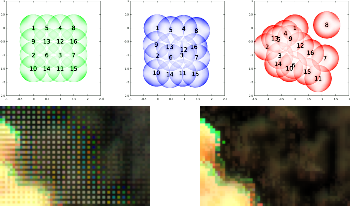
Traditional super-resolution processing computes sub-pixel alignment over a sequence of image captures to allow sampling at a finer spatial resolution. Alternatively, the mechanism intended to implement in-body image stabilization (IBIS) can be used to shift the sensor in a stationary camera by precise fractions of a pixel between exposures. The implicitly perfect alignment of pixel-shift images reduces post-processing to interleaving of raw data, but motion of camera or scene elements produces disturbing artifacts. Determining misalignments on raw images from cameras using color filter array (CFA) sensors is potentially problematic, so the synthesized super-resolution image is instead typically built from already-interpolated image data, with a reduction in tonal quality. The current work instead directly models the certainty, or confidence, with which pixel values are known. Sub-pixel alignment may be computed on either raw or interpolated image data. Still, only the underlying raw samples have precisely known values, so only they are used to compute the super-resolution image. However, primarily due to motion, even raw pixel values can have variable value certainty. Thus, a confidence metric is calculated for each raw pixel value and used as a weighting factor in computing the best estimate for the value of each super-resolution pixel.
Henry Gordon Dietz, "Leveraging Pixel Value Certainty in Pixel-Shift and Other Multi-Shot Super-Resolution Processing " in Electronic Imaging, 2024, pp 142-1 - 142-7, https://doi.org/10.2352/EI.2024.36.15.COIMG-142
 Find this author on Google Scholar
Find this author on Google Scholar Find this author on PubMed
Find this author on PubMed